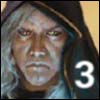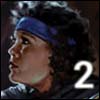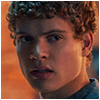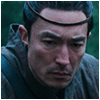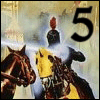So finally we come to it. The culmination of thousands of years of dueling prophecies, good vs. evil, light vs. dark... it all comes down to this. Like the previous volume, I had to wait for this one to come out in paperback. As a teenager, I would sadly look at the hardback in my local B. Dalton or Waldenbooks, resist opening it to read it bit by bit on each visit to the store. I'm pretty sure I bought the paperback at Southroads Mall in Bellevue, NE, when I was in the 10th grade (not long before I first started The Wheel of Time).
Apparently that mall is long dead; we used to go to movies there a lot, but I personally stopped going after high school, stores closed and half of it was empty by that point. I find empty malls to be disconcerting and a bit scary. Makes me think of all the properties they've built in China, which sit empty, like ghost towns.
Man, was that really 22 years ago?
Also of note, as far as I know, The Seeress of Kell was Eddings's first and only #1 NY Times Bestseller.
Before You Continue
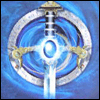
- This blog is part of my The Belgariad / The Malloreon Retrospective
- See this blog post for an overview of the Retrospective
- These blogs are not plot recaps—they are most effective in conjunction with your own re-read of the series
- Warning: CONTAINS SPOILERS FOR THE ENTIRE SERIES
The Cover
This time, I actually have something to say about the cover: I don't like it. Of all the things they could portray on the final cover of an epic 10-book sequence... they show two knights jousting? Really?

I mean, I get that it reflects the dual nature of the Prophecies, and how they constantly meet and "battle" throughout time, but this cover is quite underwhelming. The Perivor section of the book is not bad (more on that later), but there are so many better things they could have put on the cover.
The party approaching Kell, its giant mountain in the background. Garion and Zakath fighting the dragon on Perivor. Arriving at the Place Which is No More. The party in the presence of the Sardion. And on and on... they could have done so much better with this cover.
If you've read my blogs on The Wheel of Time, you've probably noticed that I'm not impressed by most covers, because most covers suck. These days I generally prefer some kind of landscape or abstract imagery - no characters. Because artists rarely draw characters properly.
However, take a gander at the alternate covers for The Seeress of Kell on the David Eddings Wikia. Some are definitely better, probably the most amusing is the French one (shown farther down in this post).
Poledra
And so we finally learn the truth. Poledra did not die giving birth to Polgara and Beldaran all those thousands of years ago. She was visited by UL and told that she would need to make a sacrifice in order for the prophecy to take the right course and Belgarath and Polgara to fulfill their individual destinies.
I would say this was not exactly a shock to me, but it was a pleasant surprise. It's also quite brutal to think about what she gave up for all this to come about. She essentially had to walk away from her family for 4,000 years. That's a long time, if you haven't noticed. It's almost impossible to imagine what living that long is like; you'd think these people would go insane or be bored out of their minds living that long.
Anyway, Poledra is back for reals, she's the final addition to our party (The Woman Who Watches), joining them as the injured she-wolf at the beginning of the novel, revealing herself later on. Belgarath will finally have to change his vagabond ways. It's an interesting parallel to the way the world has been stuck in the same state, with very little change since Torak cracked the world. Belgarath and his family can get on with their real lives, much like the world can get on with progressing once the two prophecies end.
Beldin's Place in Prophecy
One thing that bothered me when I first read these last few books was how Beldin kept hanging around the party. He was not mentioned by Cyradis in the first book as a necessary member of the group. Yet from Book 3 onward, he's with the party every step of the way. Usually the Prophecy is pretty strict about those things. What gives?
Well... we learn why in this final book. It seems that Zandramas cheats by trying to kill Garion's friends here and there. And since the Prophecy lets that go, they allow Beldin to tag along on the Light side, when normally something would happen to keep him away. How convenient.
Chaldan... or Chamdar?
I only mention this because it's one of the most notable printing errors I've ever seen in a book, and I shake my head every time I read it. In The Seeress of Kell, the god Chaldan (patron god of the Arends) is referred to numerous times as Chamdar. Which, if you remember, is the Grolim who killed Garion's parents, and who Garion killed way back in Book 2 of The Belgariad, Queen of Sorcery.
I don't know if this error was in the hardback version, or something unique to the paperback version. I'm also assuming it has since been corrected. I honestly have never checked current versions in stores today. But either way, someone failed miserably when prepping this novel for publication. A book goes through many hands and is reviewed many, many times. How could they all have missed this?
Kell
Onto the locations for this volume. Kell is somewhat shrouded in mystery, due to its remoteness, reclusive inhabitants and the fact that any Grolims that come near it are instantly struck blind. But our party has the blessing of Cyradis, the eponymous character of this book, and considering they are not Grolims, they are allowed to approach Kell.
And for once, our party is in the lead. Yay! They've passed Zandramas, who being a Grolim, cannot go to Kell. So she must wait for them to leave and follow them for a change. Belgarath and Beldin are quite happy about this, though Garion seethes as usual, as he only wants his son back.
Anyway, Kell sits in the shadow of a massive mountain, the tallest in the world, one which no one has ever climbed. Zakath is surprised at how advanced the place is. He thought he knew everything about Mallorea... he is the Emperor, after all. The people are rather dull, though. Our party is here only briefly, to pick up Cyradis and for Belgarath to look at the only true copy of the Mallorean Gospels, which will tell him the location of the Place Which is No More.
They also learn that Seers have the knowledge of all the other Seers before them - they've been making choices at each meeting of Light and Dark ever since it began, and have existed for that sole purpose. I've always found it odd that people like Polgara and Belgarath know very little about his. They've lived for thousands of years. Not once did they explore Kell? Of course, you can always explain it away with Prophecy. It didn't want them to go there, so any time they tried, something else happened to keep them away. How convenient.

Perivor
It almost feels like Eddings finally ran out of interesting cultures to toss into his world, so instead of trying to create something new for Perivor, he simply reused Arendia. Perivor is populated by descendants of shipwrecked Mimbrate Arends, so it's very medieval and formal, lots of theeing and thouing, knights and chivalry, things like that.
Cyradis tells our party they must go to Perivor to learn specifics regarding the location of the Place Which is No More. Once there, Garion and Zakath have to keep their identities hidden by wearing their full armor at all times. That sounds like it sucks. They fight another dragon (a real one, not Zandramas) and have a final run-in with Naradas, Zandramas's top cohort, who managed to become the King of Perivor's most trusted councilor and advisor in a matter of days, just before our party gets there. How convenient. It's the archetypal evil-sycophant-influences-a-good-king storyline that you find all throughout fantasy and plays out as expected (Naradas dies, the King realizes he's been duped and now helps, Garion and Zakath can reveal their identities).
So after much foul treachery and flowery language, our heroes journey posthaste to the last major location of the story...

The High Places of Korim
Eddings has teased us about this location the entire series, but finally, in the first section of this book, when our party stops in Kell, we learn that the Place Which is No More is the High Places of Korim.
This is a location that I believe is referenced back in The Belgariad, when the tale of how Torak cracked the world is told. The High Places of Korim is where he went to do the deed, creating the Sea of the East and splitting the world into the two major continents. So it's only fitting that this would be the place where the Prophecies come together and all is mended.
In current times, instead of a mountain top, this is a reef in the ocean called the Turim Reef. I think they messed up the map, though, since it says Korim Reef, despite everyone referring to it as Turim Reef. Anyway, there's a cave where the Sardion has resided for centuries and it is here that the final meeting of Childs Light and Dark takes place.
No much else to say about Korim. It's not a land or a kingdom, but since it has a section in the book, I'm obligated to cover it.

The Last Sacrifice
Good guys rarely die in fantasy stories, it seems. At least not those in the 80's and 90's. Eddings did kill someone in The Belgariad - only to bring him back to life a chapter later. That would be Durnik. This time, however, it's a permanent death. Gasp! Apparently each meeting of Light and Dark involves a sacrifice of some kind. Foreshadowed since the end of Book 1, Guardians of the West, we knew it was coming.

Unsurprisingly, Toth is one who dies. Toth, who is fairly invisible and one-dimensional (though not as bad as Eriond, who goes chapters without being mentioned or speaking). It's also completely given away when they start talking about their tasks and Ce'Nedra thinks she is going to die because she hasn't done hers yet (though she has; she told Zandramas where the Meeting is). You think about the other characters and realize they all had specific tasks that were called out as completed (even the little snake Zith)... except Toth and Eriond. Since you know what's in store for Eriond, that only leaves our mute giant.
When I get to his death, I'm actually more sad that Durnik has lost his friend than the fact that Toth is dead. He was a gentle and nice man, but not a very prominent character that I really cared about. He was just kind of there, fishing with Durnik, providing some muscle here and there.
The Choices We Make
It seems rather odd that after all this time, after thousands of years of dual prophecies and constant crafting of events, that it all comes down to Cyradis simply choosing between two people, Geran and Eriond. That's it. She just picks one and that's the winner. How convenient.
Well... what did you expect? Another sword battle? That's probably the worst way to chose a victor. Trial by combat isn't about right or wrong, or what's just, it's simply who is stronger or more clever than someone else. Thinking about what you're choosing, considering it from all sides and then making the choice - logically - that's a better way to decide between Light and Dark, yes?

Of course, this makes for a rather dull climax. Cyradis wrings her hands a bit and she's supposed to just make a choice without thinking about it... but you know she has been influenced by the Light side while travelling with them. How could you not choose the Light in her position?
Speaking of choices, the fact that Garion isn't sure at first who to choose for the new Child of Light makes me wonder how dumb he really is. He regards his companions and wonders who he should choose, and hopes he doesn't screw it up. Really? This isn't the first time he's been portrayed as an idiot. Remember the birds and the bees in Guardians of the West? The way he acted when Ce'Nedra was giving birth? Enough said.
The Places We Didn't Go
In The Belgariad, Eddings cleverly crafted a story that took us to every country and kingdom in the western continent, and had our main characters meet every monarch in the process (Garion met them all in person, except for King Gethell of Mishrak ac Thull... but then no one cares about the Thulls, so it doesn't matter).
In The Malloreon, Eddings did something similar, but there are some distinct places he missed. Though our party set foot in each major "kingdom" (Ancient Mallorea, Karanda, Melcene Empire, Dalasian Protectorates), large sections were never explored. The biggest omission is Gandahar, a jungle-like part of Melcene which I've always imagined as analogous to India. In Sorceress of Darshiva, the armies of Zandramas and Urvon feature elephants, which come from Gandahar. It's mentioned many times, but our party skips it.
Most of the Dalasian Protectorates are ignored as well. We go to Kell, of course, but aside from that, only a few ports are visited briefly in this last volume. Given how unremarkable most of the cultures on this continent have been (compared to The Belgariad and its melting pot of anachronistic cultures), it's not a big surprise. That and the fact that Eddings only had 3 books to tell the entire journey over Mallorea (compared to the 5 in The Belgariad), as we didn't reach Mallorea until partway through Book 3.
A Fond Farewell
As I've mentioned before, occasionally Eddings would jump back to the characters we left behind, providing a usually boring update on what the rest of the world is doing while our party is questing. And at the end of the day, Barak and Co. just happen to arrive at Korim after the Meeting, to give our party a lift back to Perivor and ultimately home in the western continent. How convenient.
Turns out, this gathering of at least one person that could represent each sovereign nation in the world provides an excuse to create a new peace treaty, called the Accords of Dal Perivor, the most obvious sign of the new age that has just begun. Now that Eriond is god of the Angaraks, peace shall reign in the world, and this is the first step.
This also sets up a - again, convenient - way of saying goodbye to virtually every character that we've come to know and love over the course of 10 volumes. One by one we drop them off over the next few chapters, saying one last goodbye to everyone. It's actually very nicely done, and a great way to close the saga. So Eddings is forgiven for working Barak and Co. back into the story when they were supposed to be absent.
And then there's the Epilogue, giving us a quick look at Garion and family a year or so after the Meeting...
But Wait, There's More!
Twins?! Polgara had twins? Yes, she did. Finally, Polgara becomes a mother, an indication that the stasis her and some others (like Belgarath, and progress in the world in general) have been in has come to an end. We have entered a new age, everyone is happy and there's really no more adventures to tell of, not when our enemies have changed for good (Angaraks moving from evil Torak to benevolent Eriond).
Of course, Eddings and Lester Del Rey thought otherwise. Not content to let the saga end after this, riding the popularity of the series, Eddings wrote 3 more books in this world - two character biographies that function as a mix of prequel and history lesson, and one reference text - all co-authored with his wife, Leigh.
The character biographies are for Belgarath and Polgara, unsurprisingly. Who else would get an entire novel to themselves? The books are entitled Belgarath the Sorcerer and Polgara the Sorceress. I've only read them once, back when they came out. So it will be fun to finally read them again, almost for the first time.
The reference book is The Rivan Codex, which I have not read. It mostly concerns background material for the series, along with some essays by Eddings on fantasy. I have no idea what to expect, but it will be a good one to end this retrospective on, since it's Eddings's own look back on his series.
Stay tuned for blogs on for those.
The Belgariad / The Mallorean
Next
2014-03-14 Eddings [Novel] Belgarath the Sorcerer (1995)
Previous
2013-04-16 The Malloreon [4] Sorceress of Darshiva (1989)
2013-02-28 The Malloreon [3] Demon Lord of Karanda (1988)
2013-01-31 The Malloreon [2] King of the Murgos (1988)
2012-12-12 The Malloreon [1] Guardians of the West (1987)
2012-10-26 The Belgariad [5] Enchanter's End Game (1984)
2012-10-12 The Belgariad [4] Castle of Wizardry (1984)
2012-09-11 The Belgariad [3] Magician's Gambit (1983)
2012-08-18 The Belgariad [2] Queen of Sorcery (1982)
2012-07-09 The Belgariad [1] Pawn of Prophecy (1982)
2012-06-20 The Belgariad / The Malloreon - The Retrospective
